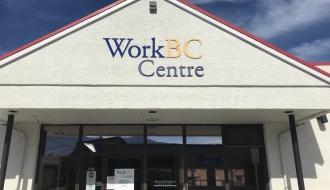Career Overview
This group includes food counter attendants, food preparers, kitchen helpers, food service helpers and dishwashers. They work for restaurants, cafés, hotels, fast food outlets, cafeterias, hospitals and other establishments.
Job Titles
Duties
The duties of workers in this group may overlap depending on the business.
Food counter attendants and food preparers:
- Take foods orders and serve customers at food counters or buffet tables
- Prepare, heat and finish cooking simple food items
- Accept payments, operate point of sale devices and give change for cash transactions
- Answer customer questions about menu items
- Use a deep fryer, grill, oven, drink dispensers and other equipment to prepare fast food items such as sandwiches, hamburgers, fries, ice cream dishes and milkshakes
- Use equipment to prepare hot beverages such as coffee and tea
- Peel, slice and trim food items using manual and electric appliances
- Stock refrigerators, cupboards and salad bars
- Keep records of quantities of food used
- Prepare food for the next day’s service
- Make sure food is kept at temperatures that meet food safety standards and practices
- Clean kitchen areas and dispose of garbage
- Clear tables, trays and chairs, and clean and reset tables
- May portion, plate and wrap food for service to patrons
- May package take-out food
Kitchen helpers:
- Help prepare or serve food and beverages
- Clear and clean tables and trays
- Clean kitchen areas and equipment, and sweep and mop floors
- Unpack and store supplies in refrigerators freezers and storage areas
- Wash, peel and prepare basic food items
- Bus dishes and perform other duties such as scraping, stacking or washing dishes, carrying linen to and from laundry area and running errands
- Refill condiments and other supplies at tables or in serving areas
- May also separate, remove and clear kitchen garbage
- May also weigh, measure and prepare ingredients for complex dishes, stir and strain soups, and grind meats, poultry and seafood
Food service helpers:
- Clean kitchen areas and equipment
- Clear, clean and set tables
- Bus dishes, clear trays, scrape and stack dishes
- Carry linen to and from laundry area
- Refill condiments and other supplies at tables and in serving areas
- May also weigh, measure and prepare ingredients for complex dishes, stir and strain soups and grind meats, poultry and seafood
Dishwashers:
- Wash dishes, glassware, flatware, pots and pans either with a dishwasher or by hand
- Sweep and scrub floors, sort and remove garbage and wash garbage cans
- Clear tables, clean kitchen areas and place clean dishes in storage areas
- May also clean and prepare food, and keep kitchen work areas clean and organized
- May load and unload trucks picking up or delivering food and supplies
Earnings
Earnings is income that workers receive in exchange for their labour. Depending on the type of employment, earnings can be in the form of wages (hourly), salaries (fixed monthly or annual) or self-employed earnings.
Work Environment
# Workers Employed
48,465% Employed Full Time
19%Food counter attendants, kitchen helpers and related support workers work days, evenings, weekends and holidays. Hours tend to be irregular but flexible and split shifts are common.
Workers in this group typically stand for long periods of time and often carry heavy trays. They work in kitchens that are hot, humid and fast-paced.
Career Pathways
There is a great deal of mobility between jobs in this group.
Movement into other food preparation and service jobs, such as cook or waiter, is possible with further training and experience.
Workers may also move into shift supervisor and management positions.
Related Careers
Occupational Interests
It’s important to understand what kinds of occupations align with your interests.
For more about occupational interests visit Skills for the Future Workforce > Characteristics.
Here are the top occupational interest(s) for this career profile:
Education, Training and Skills
Food counter attendants, kitchen helpers and related support workers may need some secondary school education.
They may also need:
- Experience working in a customer service environment
- A FOODSAFE certificate
- A Serving it Right certificate (for liquor service and sales)
- Workplace Hazardous Materials Information System (WHMIS) training (for safe use of cleaning supplies and other workplace chemicals)
- Fluency in spoken and/or written English
- Some basic mathematics and arithmetic to calculate customer transactions
- Good customer service skills
Education programs in B.C.
The following program areas are related to this occupation:
- Academic/Basic Upgrading

Skills
Every job calls for a certain set of skills. Knowing those skills is the first step in finding a good career fit.
Here, you will find the 10 most relevant workplace skills. Some are more important to achieving success in a certain career than others. These skills may come naturally to you or you may need to gain them through education, training and experience.
See the list of work-related skills below, ranked in order of importance for this career. Check out the list and see if this career matches your skills—take that first step!
Giving full attention to what other people are saying, taking time to understand the points being made, asking questions as appropriate, and not interrupting at inappropriate times.
Actively looking for ways to help people.
Talking to others to share information effectively.
Adjusting actions in relation to others' actions.
Being aware of others’ reactions and understanding why they react as they do.
Keeping track of and assessing your performance, other individuals, or organizations to make improvements or take corrective action.
Using logic and reasoning to identify the strengths and weaknesses of alternative solutions, conclusions or approaches to problems.
Managing one’s own time and the time of others.
Considering the relative costs and benefits of potential actions to choose the most appropriate one.
Understanding written sentences and paragraphs in work-related documents.
Labour Market Statistics
Discover data, facts and information that have been gathered and analyzed. Learn about the characteristics of the economy and labour market in B.C.
Employment
Find out about employment types and trends by region and industry.
Employment
48,465Employment by Region







| Region | Employment | % Employment of this Occupation |
|---|---|---|
| Cariboo | 1,445 | 3.0% |
| Kootenay | 1,350 | 2.8% |
| Mainland/Southwest | 29,650 | 61.2% |
| North Coast and Nechako | 760 | 1.6% |
| Northeast | 760 | 1.6% |
| Thompson-Okanagan | 5,770 | 11.9% |
| Vancouver Island/Coast | 8,740 | 18.0% |
Labour Market Outlook
The B.C. Labour Market Outlook is a 10-year forecast of the expected supply and demand for labour in the province. It’s usually updated every year. The purpose is to provide British Columbians with the knowledge to make informed decisions on careers, skills training, education and hiring.
Forecasted Job Openings (2024-2034)
16,360Forecasted Job Openings
Forecasted Employment Growth Rate
Composition of Job Openings
Job Openings by Region (2024-2034)







| Region | Job Openings | Avg. Annual Employment Growth |
|---|---|---|
| Cariboo | 220 | 0.8% |
| Kootenay | 350 | 1.0% |
| Mainland/Southwest | 11,260 | 1.6% |
| North Coast and Nechako | 110 | 0.9% |
| Northeast | 80 | 0.4% |
| Thompson-Okanagan | 1,710 | 1.2% |
| Vancouver Island/Coast | 2,630 | 1.2% |
Industry Highlights
Learn about the opportunities in B.C.'s major industries, including employment trends, earning potential, locations of work and more.
Forecasted Job Openings by Industry
| Industry | Job Openings (2024-2034) |
|---|---|
| Accommodation and Food Services | 12,550 |
| Health Care and Social Assistance | 1,640 |
| Retail Trade | 1,030 |
| Manufacturing | 350 |
| Information, Culture and Recreation | 240 |
Resources
Resource information is currently not available.








